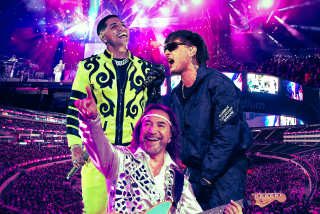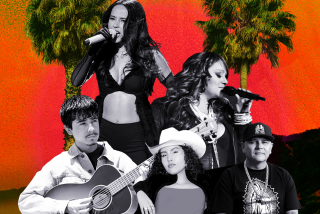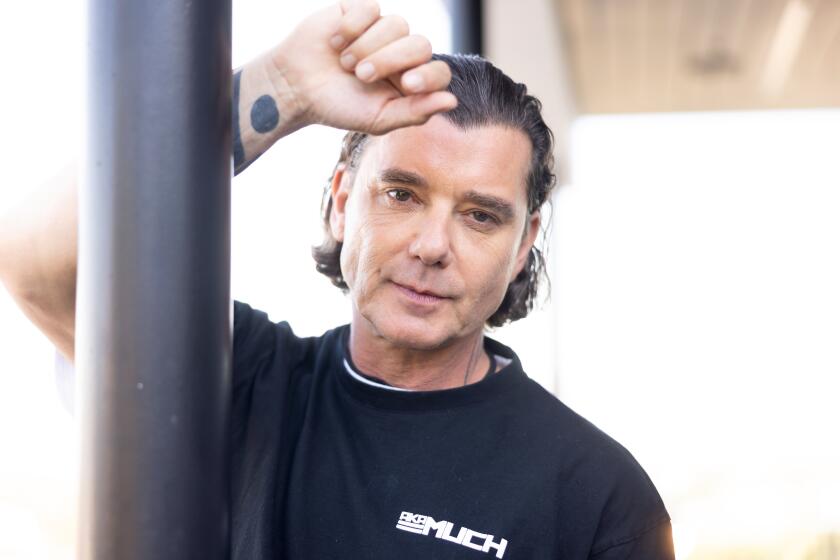At Chella fest, Indio locals enjoy Coachella’s Latin lineup closer to home
- Share via
Julie Herrera has been to the vast, expensive Coachella Valley Music and Arts Festival a few times before. But on Wednesday night, on a bench outside Indio’s Riverside County Fairgrounds, the 29-year-old from Coachella felt a little more at home.
“My mom used to play Los Tucanes de Tijuana when we were growing up,” she said, just before the legendary Norteño band took the stage for the second annual Chella festival. “I love that this brings more diversity, and more music in Spanish.”
That’s the point of this mini-festival, produced by Coachella promoters Goldenvoice. It’s held off-site, between weekends and aimed mostly at a local Latin music crowd.
As the crowds and tickets have crept out of reach for many working-class Coachella Valley locals, Chella is a small way to make some of the fest’s Latin lineup more accessible to a longtime fan base here — folks who were living and dancing long before Goldenvoice found the Polo Grounds.
The lineup — Tucanes, Chilean singer-actress Mon Laferte, Oxnard’s blissed-out disco producer Cola Boyy and folk rockers Giselle Woo & the Night Owls — put some of Coachella’s more prominent and rising Latin acts in a much more intimate setting (and at $30, a much cheaper price). Tucanes and Mon Laferte played Coachella’s Main Stage, Cola Boyy on the new punk and indie-focused Sonora Tent.
For Cola Boyy, who grew up in Anderson .Paak’s Ventura County hometown but still far away from L.A. tastemakers, the combination of playing Coachella and Chella underlined his roots and ambitions in both worlds.
FULL COVERAGE: Coachella 2019 »
“My family was at Coachella; it was the first time my mom had seen me perform as Cola Boyy,” said Matthew Urango, who has Afro-Latino roots and grew up in an almost entirely Latino neighborhood. “It was a great turnout, the place was jumping and my mom cried, it meant so much to me that she got to see me moving upwards with music.”
But if Coachella signaled a bright future for him in the mainstream music business, Chella brought that same music closer to the communities and activist circles he grew up in.
“It made me happy to see black and brown people in the crowd,” he said. “Rene [Contreras, the Goldenvoice promoter behind Chella] is making a real effort to do this, and it’s not easy to fight to make shows like this happen. But it’s a real step.”
Out in the crowd on Wednesday, the scene was much different than at Coachella’s glossy desert bacchanal. Families with small children danced in tight circles together; young Latina girls on their dads’ shoulders watched Mon Laferte sing with wide eyes and big smiles.
Older couples in cowboy hats and shiny silver belts watched Cola Boyy’s set with shared small-town pride and swayed to every one of Tucanes’ gunslinger corridos. Earlier in the week, Tucanes received the key to the city of Coachella, a first for any act playing the festival.
Just like Coachella introduced some young fans to legacy acts they’d never seen before, Chella did the same for some millennials in the crowd.
“I didn’t know who was going to be playing here, I didn’t know at first who Los Tucanes were,” said Jessica Lopez of Indio. After their set, the 35-year-old said she was going to go home and start listening much deeper. “I liked that this show made me want to do my research. Now I want to go hear more of them.”
The first Chella last year had a similar mix of heritage and hipster acts with cumbia from Los Angeles de Azules and indie-teen balladry from Cuco and experimental electronic music from Helado Negro. The difference this year is that Spanish-language pop had plenty of headline billing all itself.
Reggaeton singer J Balvin, rising Latin trap star Bad Bunny, Mon Laferte (one of Chile’s most popular musicians) and the Spanish flamenco-electro singer Rosalía all had prime-time slots on major stages. Chella was no longer a side gig to highlight Spanish-language music on the main bill — it was a sign of where the main bill was headed.
“At this point, the festival is kind of at its peak, so it’s good that they’re trying to bring more Latin music into it,” said Beto Herrera, 30, from the Coachella Valley.
Chella is, in other ways, an acknowledgment that the main festival is financially beyond many of the fans in the Coachella Valley whose cities have been profoundly affected and transformed by the rise of the mega-festival, which along with its country-cousin Stagecoach, now takes the area over for nearly all of April.
Chella is a nod to the intergenerational influences of those audiences who have been here before and will be here long after Coachella’s rise to define the U.S. festival scene.
But the fest — which packed the main auditorium on the fairgrounds — could be a contender in its own right. Festival culture shouldn’t just be for the Instagram elite. For the artists playing Chella after the main gig and big, mixed crowds, this felt like coming home and seeing the future all at once.
“Its cool to see Latin artists expanding their audiences. People are just down for songs in Spanish,” Urango said. “These artists are uncompromising, and the music industry just kind of has to bend the knee. That feels like power to me.”
For breaking music news, follow @augustbrown on Twitter.
More to Read
The biggest entertainment stories
Get our big stories about Hollywood, film, television, music, arts, culture and more right in your inbox as soon as they publish.
You may occasionally receive promotional content from the Los Angeles Times.











